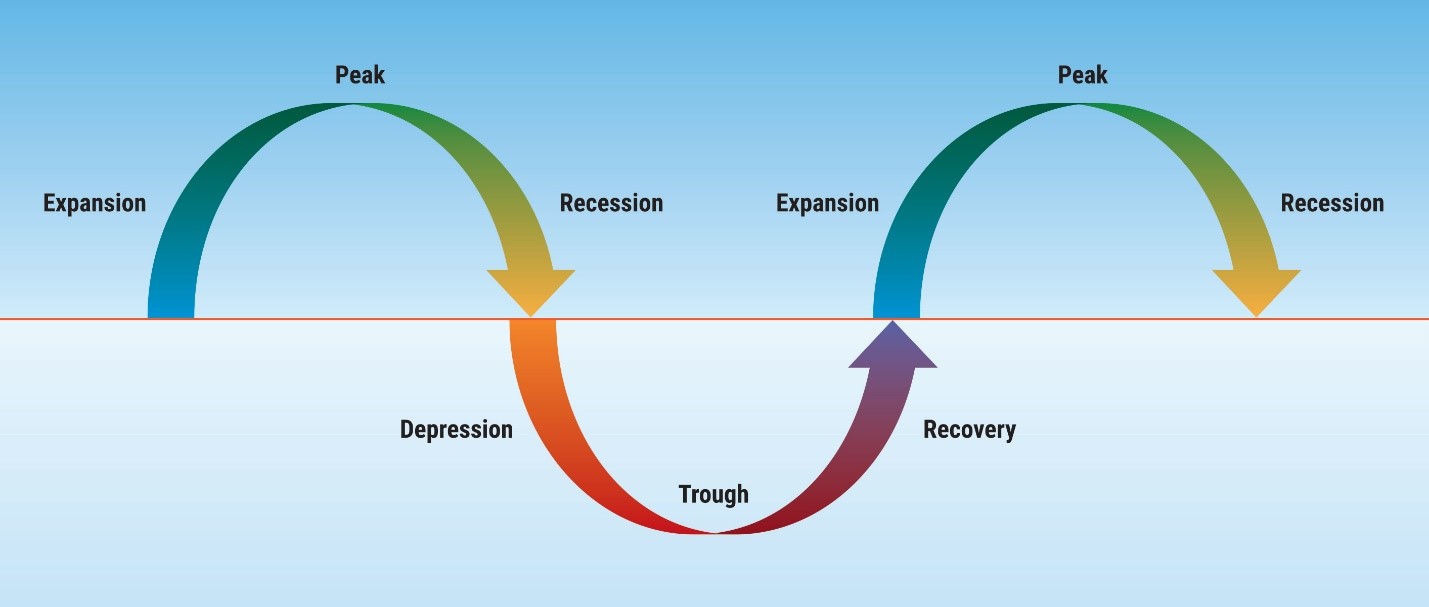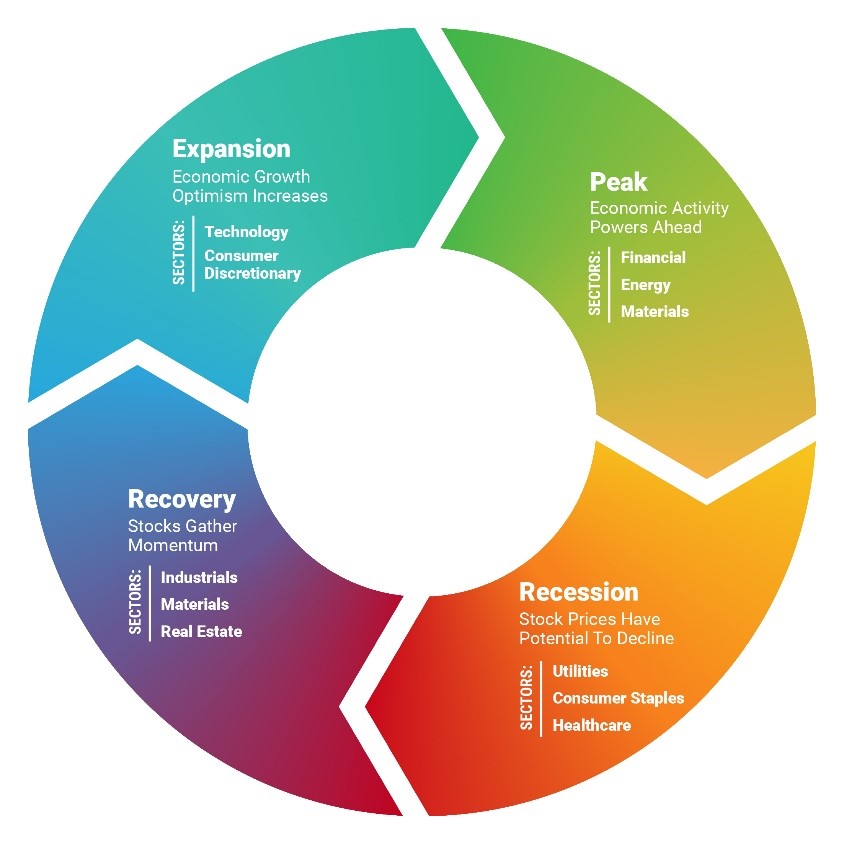An Introduction to the Business Cycle
The aim for many investors is to grow their portfolios in-line or above a major stock market benchmark index. Market timers will aim to join in the upside of the stock market and avoid as much of the downside as they can. Others will attempt to outperform the broad market index by superior stock selection. That means by owning stocks that do better than average when the market goes up and avoiding those that underperform. However, there is another investing angle that is often considered in the investing process. Savvy investors attempt to invest according to the business or economic cycle.

It is thought that certain companies do better than others at certain times of the economic cycle. This image shows the six stages of a business cycle. While the steps of a cycle might look easily defined on paper, economists and analysts often disagree about exactly where we are at any moment in time. It is hard to say how long any stage of the cycle will last making this style of investing that much harder.
A very simple example could be investing in banks when interest rates are rising. Why? Well, when the economy is expanding rapidly, the central bank moves to head-off potential inflation by increasing interest rates (or raising the cost of borrowing) under the assumption that vigorous growth will likely continue. As the yield curve moves higher and the relative price of loans increases relative to the cost to borrow in the short-term, banks are well-positioned to grow earnings. Given this context, investors tend to favor banks and other companies in the financial sector when economic growth is taking off. In this chart you can see sectors that may lead the pack relative to ones view of the current Economic Cycle.

One of the major tasks here is to identify precisely where we are within the economic cycle in order to outperform a benchmark. And on the flip-side, there are what are known as defensive stocks or safe haven assets that tend to hold up well in times of crisis.
For example, utilities companies are known for paying out high dividends to shareholders. Shares in such companies tend to do well when market rates of interest fall in anticipation of central banks’ monetary policy reductions as the economy exhibits signs of slowing. Investors are said to ‘reach for yield’ in the face of monetary policy easing.
The Business Cycle
Let’s look again at the business cycle and walk through the different stages.
Expansion – Economic growth resumes following a period of low growth or even contraction. Expansion could occur following government stimulus, through lower taxes or a boost in spending in response to a period of slow growth. When growth slows, the central bank typically reduces the cost of borrowing to reduce borrowers interest payments encouraging businesses and consumers to borrow. In response, to such economic stimulus, employers begin to take on more labor as business development initiatives are created. The rising level of employment creates additional business and consumer confidence and spending, and increased activity in the housing market. Economic growth turns positive.
Peak – While it can be easy to spot a period of sustained weak growth in advance of stimulus, it can be more difficult to identify precisely when the expansion has run its course. More often than not, the economy advances with ebbs and flows. Several economic indicators might expand in the same direction for a good length of time, before some begin to falter temporarily before resuming their advance. The actual peak in activity is often spotted in the rear-view mirror. Expansions can last for several years. Growth in the labor market leads to a marked reduction in the unemployment rate. All confidence measures are healthy, and the stock market tends to continue discounting a positive outlook. Frequently, there is not a single reason behind the high-water mark for economic growth and the peak level of output can be attributed to a variety of factors including external demand. During an expansion the central bank typically attempts to raise the cost of borrowing in response to healthy employment growth and keeps abreast for signs of building price pressures in the pipeline. The natural increase in interest rates may even be a contributing factor to the peak in the economic cycle. Inadvertently, the central bank may have attempted to protect against a build-up of inflationary forces too hard and/or too long taking away the legs of the expansion.
However, the tipping point is reached, the pace of hiring typically starts to wane, various measures of consumer and business confidence edge lower and businesses pare production in response to rising levels of inventories, indicating slowing demand. Typically, the yield curve begins to discount a period of monetary easing at the central bank as a required response to protect from the slowing economy.
Recession – A recession is officially defined as two consecutive quarters of back-to-back declines in Gross Domestic Product or GDP. Sometimes the slowing economy remedies itself after a period of such slower growth before the expansion resumes. In more protracted downturns the economy falls into depression.
Depression – A significant and protracted period of economic malaise is called a depression. These don’t happen often but when they do, it seems like no amount of policy stimulus can help budge consumers and business out of their malaise. Weak confidence feeds on itself. Consumers won’t borrow nor spend because they are pessimistic about the outlook. Because consumers are mired in woe, businesses fail to take advantage of cheap loans, because they can’t see a time when demand will start to pick-up again. Often, businesses end up sitting on bulging inventories and pare back production because they can’t sell what they already produced. They lay off more and more employees. The rate of unemployment soars and confidence falters.
Recovery – Just like it might be difficult to label the peak in economic activity, the trough in output or the business cycle is often spotted in that rear-view mirror. Businesses stop shedding workers and find that in order to meet current demand, they are forced to hire. Increased hiring leads to improvements in confidence and greater spending. And as the months go by, the economy is once again in expansion mode.
The business cycle is a difficult beast to identify and to understand. It might be easy to state that the economy is expanding, but it could be difficult to determine whether the peak to the cycle is behind or still ahead.
Yet the business cycle is important because investors attempt to concentrate their investments that are expected to do well at certain times of the cycle. One very simple example is the behavior of two different types of consumer-oriented stocks throughout the business cycle. Imagine we can define consumer staples and consumer discretionary stocks as food and automobiles. Consumers pretty much buy the same amount of food in good times and bad times. On the other hand, consumers only trade-in or trade-up their car purchases when they are not only employed, but optimistic about the safety of their jobs and confident that they could get a promotion or a higher paid job with another employer. Consumer staples tend to outperform when the stock market is not doing so well or when the business cycle is past its peak or even signaling recession. Discretionary consumer stocks tend to outperform when investors sense the economy is expanding and the outlook for employment is improving.
Here is a chart of the broad S&P 500 index. Here is a chart of the Consumer Staples sector. Can you tell which is performing better? This chart really gets to the point about why investors care about economic growth and where we are heading over the next 12-24 months in terms of the business cycle. To dig deeper, we need to look at how the economy can be broken down in to logical and meaningful sectors. Breaking down the US economy into logical pieces is no easy task. To help with that process government agencies helped create the North American Industry Classification System or NAICS for short. This helps to establish companies into sectors with broadly similar characteristics.
Resources













Buenas noches.
Podrían agregar a los subtítulos el lenguaje español….mi inglés no es tan avanzado y hay momentos en los que no entiendo
Hello Karina. If you go to the Settings for the video (cogwheel), then subtitles, you can change the language. You may have to select English first, then go back to the same setting and there should now be the option for auto-translate in a variety of languages. I hope this helps!
where is the link to the S&P 500 index and Consumer staples sector.
there seems to be no link with the mention.
thank you.
It is at the end of video.
Thanks
Thanks for engaging!
I’ve had an IB account for a while and now, reading this content, I’m starting to identify a cycle on a graph. Thank you.
We hope you continue to enjoy Traders’ Academy!
Some of our economies have been stuck in the trough for since The last two to three decades